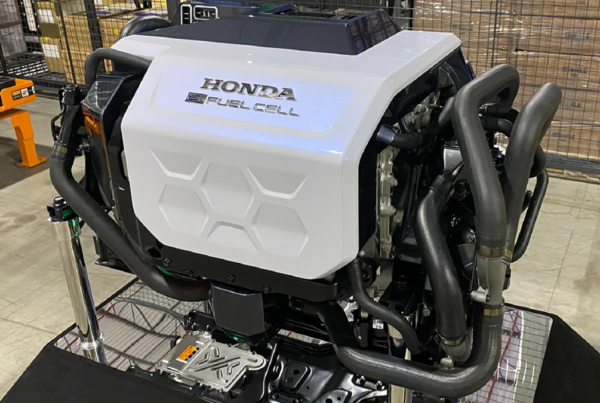
PEM FUEL CELLS – THE FUTURE IS NOW
Zero-emission mobility is more likely to come true every day with rapidly growing proton-exchange membrane fuel cells (PEMFC) technology. As one of the most efficient energy-conversion devices, PEM fuel cells convert oxygen from air and hydrogen into clean energy, leaving water as the only by product. Their low operating temperature and excellent reliability make them particularly suitable for wide applications as power source for commercial vehicle market.
HOW DOES A PEMFC WORK?
PEM fuel cells, parallelly connected in ‘stacks’, generate electricity by a series of chemical reactions that lead to water formation. In the anode, hydrogen gives up its electrons, producing H+ions. The separated electrons then travel by an external circuit to the cathode as current, which is used to power an electric traction system. In the cathode, the oxygen reacts with the incoming H+ions and electrons to form hydroxyls OH-, which further react with H+ions and electrons to produce water.
Even if the working principle seems simple, PEMFC are very delicate systems whose components need to be carefully chosen. The catalyst used at the electrodes is based on costly platinum, making it easy to poison by foreign particles in the cell that might come from the fuel or stack components.
INCREASING DEMANDS ON MATERIALS: DURABILITY, PURITY, WEIGHT
Catalyst or membrane poisoning can result in dramatic performance drop of the fuel cell, shortening its lifespan considerably. The durability of the cell directly influences its cost, hence high demands are placed on the selection of the right materials of the cell components to increase the system reliability.
Stainless steel is a suitable material for structural equipment in fuel cells such as piping, gas cylinders or valves. Owing to its toughness and ductility, the use of stainless steel is widely preferred in fuel cell parts such as piping and high-pressure tanks, where contact with high-purity and high-pressure hydrogen occurs. Despite its many qualities, stainless steel in prolonged contact with hydrogen suffers important structural changes that have negative impact on the fuel cell system, not to mention its high weight and cost. Some of the main concerns related to use of metals in PEMFC are phenomena such as hydrogen embrittlement and corrosion.
Hydrogen embrittlement occurs when hydrogen enters and diffuses into metals. As consequence, these become brittle. This phenomenon is caused by the fact that the hydrogen molecule in contact with metals splits into two atoms and enters the material in atomic state, causing a harmful effect. The extent of embrittlement depends on the amount of hydrogen absorbed and the microstructure of the material. Hydrogen embrittlement can happen in all situations where hydrogen is in direct contact with metallic parts, such as hydrogen tank and the anode loop of the fuel cell.
Another phenomenon threatening the lifespan of metal parts is their susceptibility to corrosion, especially when the metal is not coated. Metals may suffer dissolution in the acid and humid environment of PEM fuel cells, leaching ions that may poison the membrane electrode assembly, causing a decrease in the power output of the fuel cell.
OVERCOMING OBSTACLES WITH ELASTOMERS
For hoses and gaskets in the fuel cell systems, elastomers are an ideal solution. Their high degree of flexibility and light weight make them perfect candidates for hoses of complicated shapes that must fit under the hood of fuel cells vehicles.
Hydrogen embrittlement does not occur in elastomers, since in polymers, hydrogen is absorbed as diatomic molecule. The effect of hydrogen on elastomers is based on permeability, diffusivity and solubility of hydrogen into them. These parameters vary according to elastomer family and the ingredients chosen. For instance, the permeability of silicone rubber is much higher than the permeability of fluorocarbon-based fluoroelastomers.
The compounding recipe as well has an impact on the purity of the material and ions that might leach from it. For example, the acceptable leaching values of elements as halogens (F, Cl, Br, I), alkali metals (Li, Na, K, Rb, Cs, Fr) and alkaline earth metals (Be, Mg, Ca, Sr, Ba, Ra) must be evaluated.
In Venair, compounds for fuel cell hoses are tailored to meet desired characteristics and control the amount of leaching substances, while low permeability to hydrogen is maintained.
About Venair
For more than 10 years, Venair Group has been dedicated to the PEM Fuel Cell industry, collaborating, and creating, together with the world’s largest Fuel Cell manufacturers, the best solutions to scale and improve the industry worldwide.
In addition, Venair has just opened its first factory for the exclusive production of tubes for PEM Fuel Cells systems. With the support of more than 35 delegations around the world and 8 factories on 4 continents, the group intends to accompany the Hydrogen industry on its way to the introduction and democratization.
SOURCES
https://www.frontiersin.org/articles/10.3389/fenrg.2014.00002/full
https://www.twi-global.com/technical-knowledge/faqs/what-is-hydrogen-embrittlement
https://www.technology.matthey.com/article/57/4/259-271/
Read the most up to date Fuel Cell and Hydrogen Industry news at FuelCellsWorks




